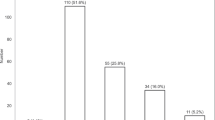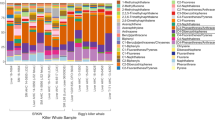Abstract
Lead levels and isotopic fingerprints in 315 free-ranging animals belonging to 18 wild game species in four remote areas of the Peruvian Amazon provide a comprehensive picture of anthropogenic lead pollution in tropical rainforests. The high average concentration of lead (0.49 mg kg−1 wet weight) in livers from Amazonian wild game is comparable to the levels of lead in industrialized countries and mining areas. Although hunting ammunition is probably the main source of lead in wildlife, oil-related pollution is also a major source of contaminant lead in areas in which oil is extracted. Owing to the extended use of lead shot in subsistence hunting worldwide and the ever-encroaching oil-extraction industry in tropical rainforests, these results uncover important health risks to tropical wildlife and local communities that rely on subsistence hunting.
This is a preview of subscription content, access via your institution
Access options
Access Nature and 54 other Nature Portfolio journals
Get Nature+, our best-value online-access subscription
$29.99 / 30 days
cancel any time
Subscribe to this journal
Receive 12 digital issues and online access to articles
$119.00 per year
only $9.92 per issue
Buy this article
- Purchase on Springer Link
- Instant access to full article PDF
Prices may be subject to local taxes which are calculated during checkout



Similar content being viewed by others
Data availability
The data that support the findings of this study are available in the Pangaea repository at https://doi.org/10.1594/PANGAEA.874916.
References
Pimm, S. L. et al. The biodiversity of species and their rates of extinction, distribution, and protection. Science 344, 1246752 (2014).
Mittermeier, R. A. et al. Wilderness and biodiversity conservation. Proc. Natl Acad. Sci. USA 100, 10309–10313 (2003).
Orta-Martínez, M. et al. First evidences of Amazonian wildlife feeding on petroleum-contaminated soils: a new exposure route to petrogenic compounds? Environ. Res. 160, 514–517 (2018).
Butt, N., Beyer, H., Bennett, J. & Biggs, D. Biodiversity risks from fossil fuel extraction. Science 342, 425–426 (2013).
Orta-Martínez, M., Pellegrini, L. & Arsel, M. “The squeaky wheel gets the grease”? The conflict imperative and the slow fight against environmental injustice in northern Peruvian Amazon. Ecol. Soc. 23, 7 (2018).
O’Callaghan-Gordo, C., Orta-Martínez, M. & Kogevinas, M. Health effects of non-occupational exposure to oil extraction. Environ. Health 15, 56 (2016).
Anticona, C., Bergdahl, I. A., Lundh, T., Alegre, Y. & Sebastian, M. S. Lead exposure in indigenous communities of the Amazon basin, Peru. Int. J. Hyg. Environ. Health 215, 59–63 (2011).
Anticona, C., Bergdahl, I. A. & San Sebastian, M. Lead exposure among children from native communities of the Peruvian Amazon basin. Rev. Panam. Salud Publica 31, 296–302 (2012).
Cheng, H. & Hu, Y. Lead (Pb) isotopic fingerprinting and its applications in lead pollution studies in China: a review. Environ. Pollut. 158, 1134–1146 (2010).
Hu, H., Shih, R., Rothenberg, S. & Schwartz, B. S. The epidemiology of lead toxicity in adults: measuring dose and consideration of other methodologic issues. Environ. Health Perspect. 115, 455–462 (2007).
Gilbert, S. G. & Weiss, B. A rationale for lowering the blood lead action level from 10 to 2 μg/dL. Neurotoxicology 27, 693–701 (2006).
Final Review of Scientific Information on Lead (UNEP Chemicals Branch, 2010).
Nawrot, T. S. & Staessen, J. A. Low-level environmental exposure to lead unmasked as silent killer. Circulation 114, 1347–1349 (2006).
Bartrons, M., Catalan, J. & Penuelas, J. Spatial and temporal trends of organic pollutants in vegetation from remote and rural areas. Sci. Rep. 6, 25446 (2016).
Robinson, J. G. & Bennett, E. L. Hunting for Sustainability in Tropical Forests (Columbia Univ. Press, 2000).
Arnemo, J. M. et al. Health and environmental risks from lead-based ammunition: science versus socio-politics. EcoHealth 13, 618–622 (2016).
Plaza, P. I., Uhart, M., Caselli, A., Wiemeyer, G. & Lambertucci, S. A. A review of lead contamination in South American birds: the need for more research and policy changes. Perspect. Ecol. Conserv. 16, 201–207 (2018).
Finer, M. et al. Future of oil and gas development in the western Amazon. Environ. Res. Lett. 10, 024003 (2015).
Neff, J. M. Bioaccumulation in Marine Organisms: Effect of Contaminants from Oil Well Produced Water (Elsevier, 2002).
Yusta-García, R., Orta-Martínez, M., Mayor, P., González-Crespo, C. & Rosell-Melé, A. Water contamination from oil extraction activities in Northern Peruvian Amazonian rivers. Environ. Pollut. 225, 370–380 (2017).
Candelone, J.-P., Hong, S., Pellone, C. & Boutron, C. F. Post-industrial revolution changes in large-scale atmospheric pollution of the Northern Hemisphere by heavy metals as documented in central Greenland snow and ice. J. Geophys. Res. 100, 16605–16616 (1995).
Correia, A. et al. Trace elements in South America aerosol during 20th century inferred from a Nevado Illimani ice core, eastern Bolivian Andes (6350 m asl). Atmos. Chem. Phys. 3, 1337–1352 (2003).
Ikegawa, M. et al. Geographical variations of major and trace elements in East Antarctica. Atmos. Environ. 33, 1457–1467 (1999).
Emmons, L. & Stark, N. Elemental composition of a natural mineral lick in Amazonia. Biotropica 11, 311–313 (1979).
Klaus, G., Klaus-Hügi, C. & Schmid, B. Geophagy by large mammals at natural licks in the rain forest of the Dzanga National Park, Central African Republic. J. Trop. Ecol. 14, 829–839 (1998).
Dudley, R., Kaspari, M. & Yanoviak, S. P. Lust for salt in the western Amazon. Biotropica 44, 6–9 (2012).
Blake, J. G. et al. Mineral licks as diversity hotspots in lowland forest of eastern Ecuador. Diversity 3, 217–234 (2011).
Beyer, W. N. & Fries, G. in Handbook of Ecotoxicology 2nd edn (eds Hoffman, D. J. et al.) 151–166 (Lewis Publishers, 2002).
Beyer, W. N. & Meador, J. P. Environmental Contaminants in Biota: Interpreting Tissue Concentrations (CRC, 2011).
Bilandžić, N., Sedak, M., Vratarić, D., Perić, T. & Šimić, B. Lead and cadmium in red deer and wild boar from different hunting grounds in Croatia. Sci. Total Environ. 407, 4243–4247 (2009).
Reglero, M. M., Monsalve-González, L., Tagart, M. & Mateo, R. Transfer of metals to plants and red deer in an old lead mining area in Spain. Sci. Total Environ. 406, 287–297 (2008).
Amici, A., Danieli, P. P., Russo, C., Primi, R. & Ronchi, B. Concentrations of some toxic and trace elements in wild boar (Sus scrofa) organs and tissues in different areas of the province of Viterbo, central Italy. Ital. J. Anim. Sci. 11, e65 (2012).
Garitano-Zavala, Á., Cotín, J., Borràs, M. & Nadal, J. Trace metal concentrations in tissues of two tinamou species in mining areas of Bolivia and their potential as environmental sentinels. Environ. Monit. Assess. 168, 629–644 (2010).
Bollhöfer, A. & Rosman, K. J. Isotopic source signatures for atmospheric lead: the Southern Hemisphere. Geochim. Cosmochim. Acta 64, 3251–3262 (2000).
Eichler, A., Gramlich, G., Kellerhals, T., Tobler, L. & Schwikowski, M. Pb pollution from leaded gasoline in South America in the context of a 2000-year metallurgical history. Sci. Adv. 1, e1400196 (2015).
de Souza, J. J. L. L., Fontes, M. P. F., Gilkes, R., da Costa, L. M. & de Oliveira, T. S. Geochemical signature of Amazon tropical rainforest soils. Rev. Bras. Ciênc. Solo 42, e0170192 (2018).
Rosell-Melé, A. et al. Oil pollution in soils and sediments from the northern Peruvian Amazon. Sci. Total Environ. 610–611, 1010–1019 (2018).
Rabinowitz, M. B. & Wetherill, G. W. Identifying sources of lead contamination by stable isotope techniques. Environ. Sci. Technol. 6, 705–709 (1972).
Pain, D. J. et al. Potential hazard to human health from exposure to fragments of lead bullets and shot in the tissues of game animals. PLoS ONE 5, e10315 (2010).
Cao, X., Ma, L. Q., Chen, M., Hardison, D. W. & Harris, W. G. Weathering of lead bullets and their environmental effects at outdoor shooting ranges. J. Environ. Qual. 1, 526–534 (2003).
Hunt, W. G. et al. Bullet fragments in deer remains: implications for lead exposure in avian scavengers. Wildl. Soc. Bull. 34, 167–170 (2006).
Fustinoni, S., Sucato, S., Consonni, D., Mannucci, P. M. & Moretto, A. Blood lead levels following consumption of game meat in Italy. Environ. Res. 155, 36–41 (2017).
Knutsen, H. K., Brantsaeter, A.-L., Alexander, J. & Meltzer, H. M. In Proc. Oxford Lead Symposium: Lead Ammunition: Understanding and Minimizing the Risks to Human and Environmental Health (eds Delahay, R. J. & Spray, C. J.) 44–50 (2014).
Bochyński, P., Kuliczkowski, M., Karpiewska, A., Turkiewicz, M. & Dobosz, T. Hunting shot—evolution of manufacturing technology. Arch. Med. Sadowej Kryminol 66, 41–64 (2016).
Monsalve, J. L. P. Depredador depredado: cacerías y comercio de jaguar en dos cuencas Andino Amazônicas. Novos Cad. NAEA 12, 109–134 (2009).
Gremse, C. & Rieger, S. In Proc. Oxford Lead Symposium: Lead Ammunition: Understanding and Minimizing the Risks to Human and Environmental Health (eds Delahay, R. J. & Spray, C. J.) 51–57 (2014).
Orta Martínez, M. et al. Impacts of petroleum activities for the Achuar people of the Peruvian Amazon: summary of existing evidence and research gaps. Environ. Res. Lett. 2, 045006 (2007).
Bodmer, R. E. & Lozano, E. P. Rural development and sustainable wildlife use in Peru. Conserv. Biol. 15, 1163–1170 (2001).
Peres, C. A. Effects of subsistence hunting on vertebrate community structure in Amazonian forests. Conserv. Biol. 14, 240–253 (2000).
Bennett, E. L. Is there a link between wild meat and food security? Conserv. Biol. 16, 590–592 (2002).
Fa, J. E., Peres, C. A. & Meeuwig, J. Bushmeat exploitation in tropical forests: an intercontinental comparison. Conserv. Biol. 16, 232–237 (2002).
Red List of Threatened Species (IUCN, 2016).
Acknowledgements
We thank the local indigenous communities of the Pastaza, Corrientes, Yavari-Mirin and Pucacuro river basins for their assistance and cooperation; members of the indigenous federations of the Pastaza and Corrientes River basins (FEDIQUEP and FECONACOR, respectively) and the contribution of their environmental monitors, especially A. Sánchez, A. Guevara, E. Hualinga, J. J. Butuna, J. P. Gayas, M. Javier, M. Cariajano, R. Dahua Mucushua and T. Arahuanaza; the Pucacuro National Reserve, the Servicio Forestal Nacional y de Fauna Silvestre of Peru and CITES-Spain; P. Pérez-Peña, N. Fernandez-Gascon, I. Calm-Raurell, P. Rodríguez, L. Vela-Alegría, A. Ferrer-Mayol and G. Pocull-Bellés for their collaboration during the study; and M. Bowler, Á. Fernández-Llamazares, J. Garcia-Orellana, D. Papoulias and C. O’Callaghan-Gordo for discussions and comments on the manuscript. This work was supported by the Fundació Autònoma Solidària, IDEAWILD, the Earthwatch Institute, the Rufford Foundation (13621-1) and the Spanish research Ministry (Maria de Maeztu Award MDM-2015-0552). M.C.-S. benefited from the financial support of the AGAUR (FI-DGR 2014, 2015 and 2016), and M.O.-M. benefited from the financial support of the Marie Curie Actions (REA agreement 289374, ENTITLE), the Conflict and Cooperation over Natural Resources in Developing Countries program of The Netherlands Organisation for Scientific Research, the International Initiative for Impact Evaluation and the Ministerio de Ciencia, Innovación y Universidades (RYC-2016-21366, funded by the European Social Fund/Investing in your Future).
Author information
Authors and Affiliations
Contributions
M.O.-M., P.M. and A.R.-M. conceived the study. M.C.-S., P.M., M.O.-M. and A.R.-M. conducted the field work, analysed the data and wrote the manuscript.
Corresponding authors
Ethics declarations
Competing interests
The authors declare no competing interests.
Additional information
Publisher’s note: Springer Nature remains neutral with regard to jurisdictional claims in published maps and institutional affiliations.
Supplementary information
Supplementary Information
Supplementary Table 1.
Rights and permissions
About this article
Cite this article
Cartró-Sabaté, M., Mayor, P., Orta-Martínez, M. et al. Anthropogenic lead in Amazonian wildlife. Nat Sustain 2, 702–709 (2019). https://doi.org/10.1038/s41893-019-0338-7
Received:
Accepted:
Published:
Issue Date:
DOI: https://doi.org/10.1038/s41893-019-0338-7
This article is cited by
-
Effects of Lead (Pb) from Smelter Operations in an Urban Terrestrial Food Chain at a Colorado Superfund Site
Bulletin of Environmental Contamination and Toxicology (2024)
-
Identifying contamination of heavy metals in soils of Peruvian Amazon plain: use of multivariate statistical techniques
Environmental Monitoring and Assessment (2022)
-
Improper estimation of lead contamination
Nature Sustainability (2020)
-
Reply to: Improper estimation of lead contamination
Nature Sustainability (2020)
-
Setting maximum levels for lead in game meat in EC regulations: An adjunct to replacement of lead ammunition
Ambio (2020)



